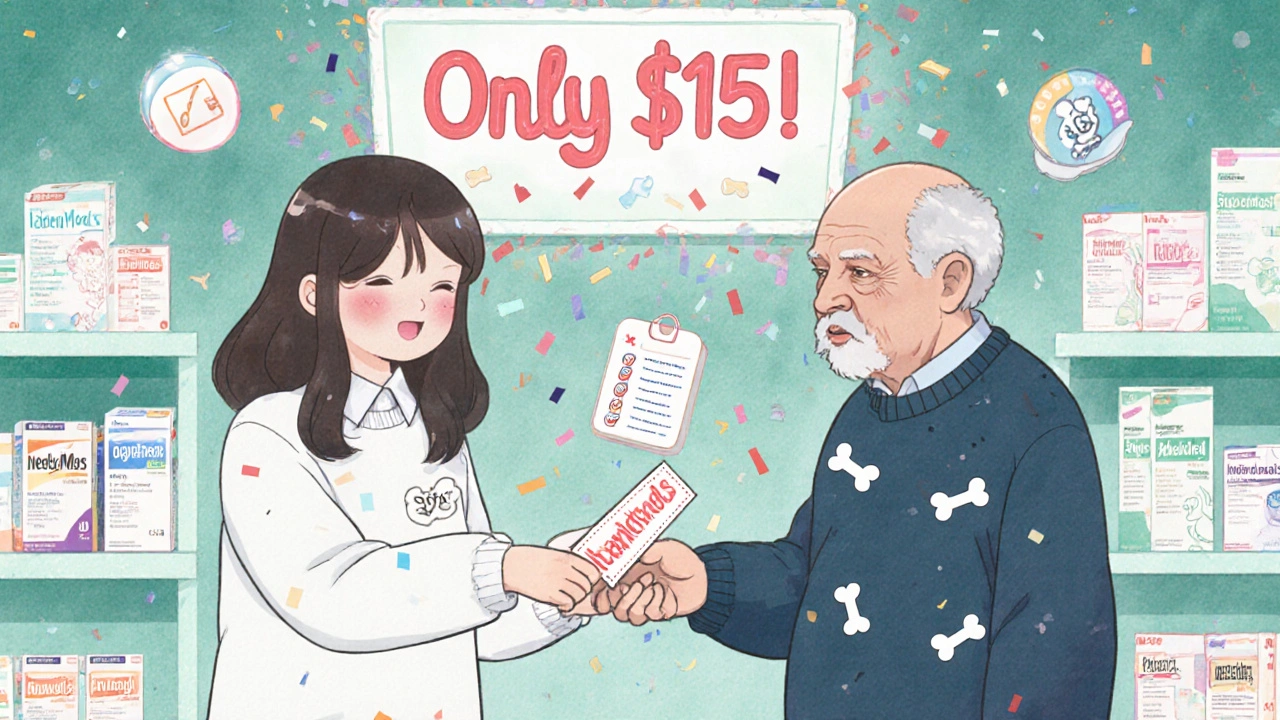Getting prescribed ibandronate sodium for osteoporosis can feel like a relief-until you see the price tag. A single month’s supply can cost anywhere from $150 to $400 without insurance, and that’s before factoring in doctor visits, bone density scans, or side effect management. For many, especially older adults on fixed incomes, that kind of expense isn’t just inconvenient-it’s a barrier to staying healthy. The good news? You’re not alone in this struggle, and help is available. Whether you’re covered by Medicare, private insurance, or nothing at all, there are real ways to lower the cost of ibandronate sodium and keep your treatment on track.
What is ibandronate sodium, and why does it cost so much?
Ibandronate sodium is a bisphosphonate drug used to treat and prevent osteoporosis in postmenopausal women. It works by slowing down bone loss, helping to keep bones strong and reduce fracture risk. The brand-name version, Boniva, used to be the only option, but generic ibandronate has been available since 2018. Even so, prices haven’t dropped as much as you’d expect.
The reason? Manufacturing isn’t the main cost driver. It’s the market structure. Unlike insulin or other high-cost drugs, ibandronate doesn’t have dozens of competing generics. Only a handful of manufacturers produce it, which limits price competition. Plus, pharmacies often mark it up because it’s a low-volume, high-margin prescription. A 150 mg tablet might cost the pharmacy $2, but they charge $120 for a monthly supply. That’s not fraud-it’s how the system works.
How insurance covers ibandronate sodium
If you have insurance, your out-of-pocket cost depends on your plan’s structure. Most Medicare Part D plans and private insurers list ibandronate sodium on their formularies, usually in Tier 2 or 3. That means you’ll pay a copay, not the full price.
For Medicare beneficiaries, the average monthly copay for generic ibandronate is $15-$35, depending on your plan’s coverage stage. If you’re in the coverage gap (the donut hole), you’ll pay 25% of the drug’s negotiated price in 2025, which usually comes to around $20-$30 per month. Some plans even waive copays entirely for osteoporosis meds under preventive care rules.
Private insurance plans vary more. Some require prior authorization before covering ibandronate. That means your doctor has to prove you’ve tried other treatments or have a documented fracture risk. Others only cover the oral tablet form, not the quarterly injection. Always check your plan’s formulary online or call customer service with the drug’s NDC code (50242-001-01 for 150 mg tablets) to confirm coverage.
Financial assistance programs you can actually use
If you’re uninsured, underinsured, or just can’t afford your copay, you’re not stuck. Several programs exist specifically to help with osteoporosis drug costs.
- Manufacturer Patient Assistance Programs: The maker of Boniva, Genentech, offers a program called Genentech Access Solutions. If your household income is below 400% of the federal poverty level (about $57,000 for a single person in 2025), you may qualify for free or deeply discounted ibandronate. Applications take about 10 minutes and can be submitted online or by mail.
- NeedyMeds: This nonprofit database lists over 200 patient assistance programs. Search for ibandronate sodium and you’ll find options from pharmaceutical companies, charities, and state programs. Many offer coupons that cut the price to $10-$25 per month at participating pharmacies.
- GoodRx and SingleCare: These apps don’t replace insurance, but they often beat even Medicare prices. A quick search shows generic ibandronate 150 mg priced at $18 at Walmart, $22 at CVS, and $15 at Kroger with a GoodRx coupon. These discounts work even if you have insurance-you can ask the pharmacist to apply the coupon instead of billing your plan.
- State Pharmaceutical Assistance Programs (SPAPs): Many states, including California, New York, and Florida, offer drug cost help to seniors and low-income residents. Check your state’s health department website. Some SPAPs cover ibandronate without requiring prior authorization.

How to get the lowest price at the pharmacy
Even with insurance, you might pay more than you should. Here’s how to ensure you’re getting the best deal:
- Ask for the cash price. Sometimes, the cash price with a coupon is cheaper than your insurance copay. Pharmacies are required to tell you the cash price before filling the prescription.
- Use a 90-day supply. Most insurers and discount programs offer lower per-unit pricing for 90-day fills. That’s three months of treatment for the price of two.
- Switch pharmacies. Prices vary wildly. A prescription that costs $80 at Walgreens might be $25 at Target or Costco (with membership). Use GoodRx to compare local prices before you leave the doctor’s office.
- Ask about therapeutic alternatives. If ibandronate is too expensive, your doctor might switch you to alendronate (Fosamax) or risedronate (Actonel), which are often cheaper and equally effective for most people.
What to do if your insurance denies coverage
Denials happen. Maybe your plan says you didn’t try a different bisphosphonate first, or they claim your bone density score isn’t low enough. Don’t accept it as final.
First, ask your doctor to file a formal appeal. They need to submit a letter of medical necessity, including your FRAX score, fracture history, or lab results showing high bone turnover. Many appeals are approved on the first try.
If that fails, you can request an external review through your state’s insurance commissioner. This is free and legally binding. In 2024, over 60% of denied ibandronate appeals were overturned after external review.

Real-life cost savings examples
Take Maria, 68, from Phoenix. She had Medicare Part D and paid $42 per month for ibandronate. She found a GoodRx coupon that brought it down to $12. Then she applied for Genentech’s patient assistance program and got it free for six months. Her total out-of-pocket for a year: $144.
James, 72, in Ohio, was uninsured and paying $380 a month. He used NeedyMeds to find a nonprofit that covered 80% of his cost. He paid $76 a month-less than his cable bill.
These aren’t rare cases. They’re repeatable. The system is designed to make you feel powerless. But with the right steps, you take control.
What you should do right now
Don’t wait until your prescription runs out. Take action today:
- Go to NeedyMeds.org and search for "ibandronate sodium"
- Download the GoodRx app and check prices at three nearby pharmacies
- Call your insurance plan and ask: "What’s my copay for generic ibandronate 150 mg? Is prior authorization required?"
- Ask your pharmacist: "Can I get this cheaper with a cash coupon?"
- Call your doctor’s office and say: "I’m having trouble affording this. Are there alternatives or assistance programs you recommend?"
Every month you delay, you risk missing doses-and that increases your fracture risk. The cost of ibandronate sodium isn’t just in dollars. It’s in mobility, independence, and quality of life. You don’t have to pay full price to protect your bones.
Is there a generic version of ibandronate sodium?
Yes. Generic ibandronate sodium has been available since 2018 and is chemically identical to the brand-name Boniva. It’s just less expensive. Most pharmacies stock multiple generic brands, and prices vary between them. Always ask for the generic unless your doctor specifically requires the brand.
Can I split my ibandronate tablet to save money?
No. Ibandronate tablets are not scored and should never be split. The drug is formulated to release slowly in the stomach, and splitting it can change how it’s absorbed. It also increases the risk of esophageal irritation. If cost is an issue, ask your doctor about switching to a lower-dose tablet or a different medication.
Does Medicare cover ibandronate injections?
Medicare Part B covers the quarterly intravenous injection of ibandronate (Boniva IV) if it’s administered in a doctor’s office or clinic. However, it does not cover the oral tablet form under Part B-only Part D. If you’re on Medicare and your doctor recommends the injection, make sure they bill it as a Part B service. You’ll pay 20% of the Medicare-approved amount after your Part B deductible.
How long does it take to get approved for patient assistance?
Most manufacturer programs respond within 3-5 business days. Some, like Genentech’s, can approve you in under 24 hours if you submit all required documents-proof of income, prescription, and ID. If you’re in urgent need, call their helpline directly. Many programs offer emergency 30-day supplies while your application is processed.
Can I use GoodRx and insurance at the same time?
No. You must choose one or the other. The pharmacy can’t combine discounts. But you can compare the cash price with your insurance copay and pick the lower one. Sometimes, the GoodRx coupon is cheaper-even for people with insurance. Always ask the pharmacist to check both options before you pay.
What if nothing works?
If you’ve tried all the options and still can’t afford your medication, talk to your doctor. There are other osteoporosis treatments with lower out-of-pocket costs. Alendronate (Fosamax) and risedronate (Actonel) are older bisphosphonates that often cost under $10 a month as generics. Even zoledronic acid (Reclast), an annual IV infusion, might be cheaper overall when you factor in monthly pill costs and missed doses.
Don’t stop taking your medication because of cost. Untreated osteoporosis leads to fractures-hip fractures, in particular, can be life-altering. One in four people over 50 who break a hip die within a year. The real cost isn’t the pill. It’s what happens when you don’t take it.
Take the first step today. Call your pharmacy. Check GoodRx. Apply for help. Your bones won’t wait.



Comments
i just got my ibandronate script and nearly cried when i saw the price. $180?? i’m on social security and this is more than my monthly phone bill. i used goodrx and got it for $15 at walmart. i didn’t even know that was a thing. thank god for apps like that. also, the pharmacist gave me a free pill organizer. small wins, folks.
Thank you for this comprehensive breakdown. Many patients are unaware of the financial assistance options available, and your clarity on Medicare Part D tiers, SPAPs, and manufacturer programs is invaluable. I encourage all providers to distribute this information proactively during consultations. Access to medication should not be determined by financial literacy.
Oh wow, so now we’re giving free drugs to people who can’t afford them? Next they’ll hand out free hip replacements. This is why America’s broke. You want cheap meds? Work more hours. Or move to a country where the government doesn’t bankrupt itself trying to fix everything. I pay full price for my meds - why should you get a handout?
OMG I just found out my cousin in India pays $2 for this same drug because they have generic factories everywhere. Why is America so broken?? I mean, I’m not even American but I’m crying right now. My aunt died from a hip fracture because she couldn’t afford it. This is a crime. Someone needs to burn down the pharmaceutical CEOs’ mansions. 😭
Just wanted to add - if you’re on Medicare and your copay is still high, ask your doctor about the Extra Help program (LIS). It’s not automatic, but if you qualify based on income, it can drop your copay to $0. Also, some pharmacies like Costco and Kaiser offer cash prices under $10 for generics. And yes, split the pill? NO. 😅 I’ve seen people do it and end up in the ER. Don’t be that person.
It is, indeed, a matter of profound regret that the American pharmaceutical industrial complex has evolved into a predatory mechanism, wherein essential therapeutics are held hostage to corporate profit margins. One must reflect upon the ethical bankruptcy of a system that permits a 6,000% markup on a molecule synthesized in a laboratory. The British NHS, by contrast, negotiates bulk pricing with precision and dignity. We must demand systemic reform - not merely coupon hacks.
LOL you guys are so cute thinking goodrx is magic. I’ve been doing this for 15 years. Half the coupons are expired, half the pharmacies lie about the price, and the other half make you sign 7 forms. Also, why are you all so shocked? Of course it’s expensive - the drug companies own congress. You think they’re gonna fix it? Nah. Just keep buying the coupons and pretending you’re saving money. Meanwhile, your bones are turning to dust. 🤡
Don’t split the pills. Ever. And yes, alendronate is cheaper. I switched. $8/month. Same results. Stop overcomplicating it.
It’s funny how we treat medicine like a luxury item. We don’t do this with insulin, not really - we just scream louder. But osteoporosis? It’s ‘old people stuff.’ So we let them suffer quietly. The real cost isn’t the pill. It’s the silence. The dignity we strip away when we make healthcare a puzzle only the financially savvy can solve. Maybe we’re not broken. Maybe we just chose not to care - until it’s our turn.
Let’s be real - 90% of these ‘financial assistance’ programs are scams. You fill out 10 forms, wait 3 weeks, then get a letter saying you ‘don’t qualify’ because your cat’s vet bill was $12 more than the limit. And don’t even get me started on NeedyMeds - it’s a graveyard of dead links and fake charities. The only thing that works? Cash price at Walmart. Everything else is noise. I’ve seen too many people waste months chasing ghosts.
THIS IS WHY I HATE AMERICA. We have the best science in the world, but we make old people choose between food and bones. My grandmother took ibandronate for 7 years. She never complained. But she cried every time she had to refill it. And now she’s in a wheelchair. Because she skipped doses. Because she was ‘too proud’ to ask for help. I’m so angry. I’m so, so angry.
For those who are uninsured or underinsured: The Patient Advocate Foundation offers a dedicated osteoporosis assistance line - 800-532-5274. They can help you navigate manufacturer programs, appeal denials, and even connect you with local free clinics that dispense generics. Additionally, many community pharmacies (e.g., independent, non-chain) offer loyalty discounts not listed on GoodRx - always ask. Documentation is key: Keep a log of all prescriptions, copays, and communications. You are not a burden. You are a patient. And you deserve care - regardless of your bank balance.